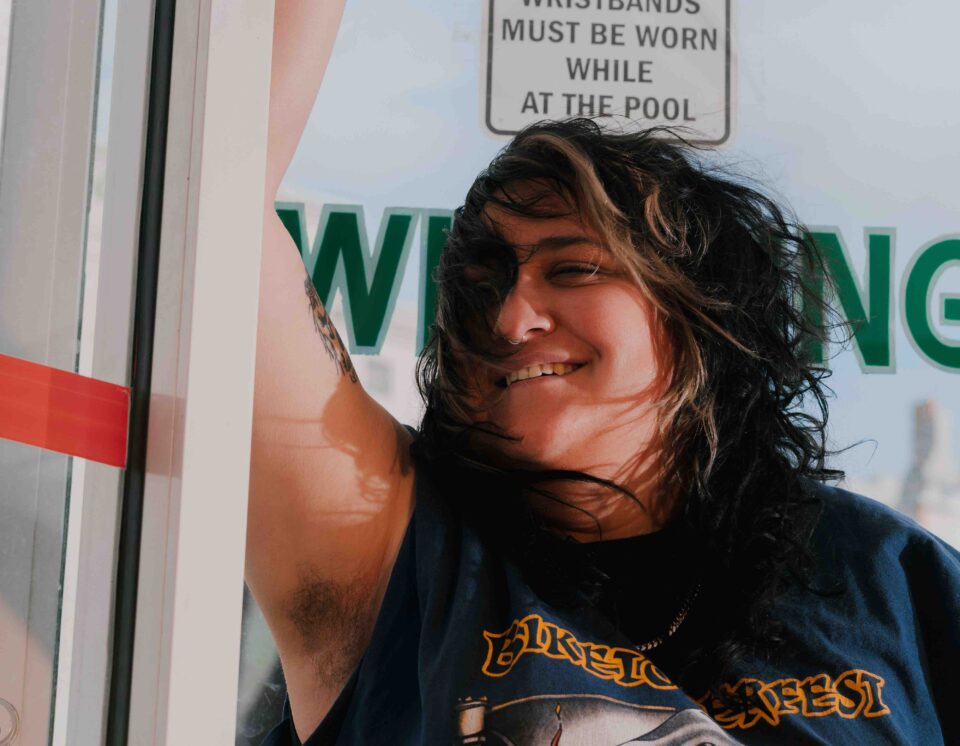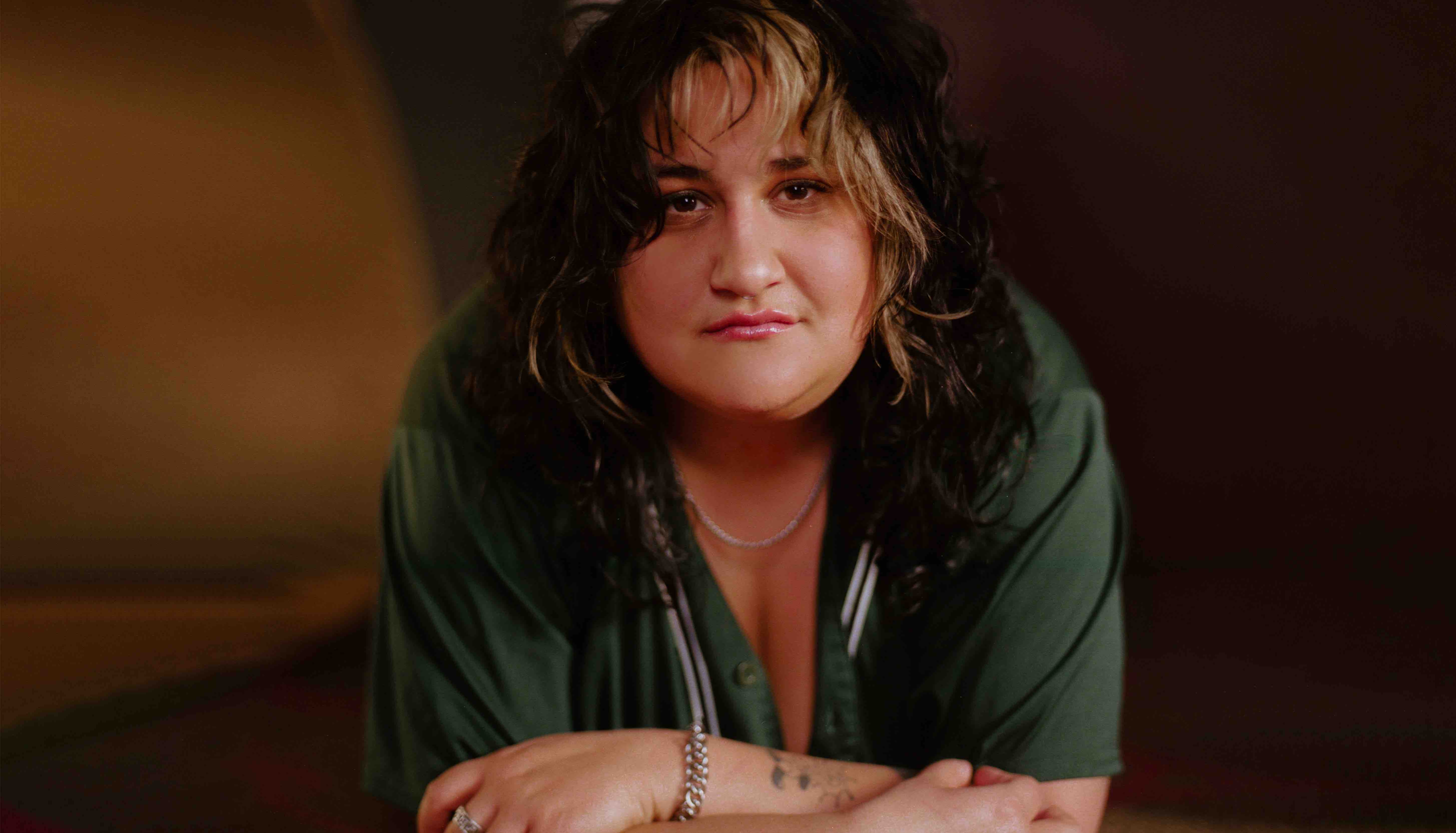There’s a wonderful paradox at the heart of Palehound’s new record Eye on the Bat, one that goes a long way in explaining what makes songwriter El Kempner such a distinct and invigorating voice in indie rock. To hear Kempner tell it, no one was ever really meant to hear a minute of the album, yet it was recorded as if for a sold-out room—two facts that remain opposed even as they shape the foundation of this record.
Eye on the Bat is without a doubt the most vulnerable work of Kempner’s career, which began back in 2013. This is a break-up record, something Kempner is not shy about revealing. It’s focused and eloquent in its naked exposure of an artist working through the minutiae of fizzled love in real time. It wasn’t precisely what they set out to do when they began penning it in 2020, but Kempner has never been one to shy away from the personal. It helped, though, that at the time they weren’t entirely sure they would ever show these songs to anyone.
Jump ahead a few years and here Kempner is promoting said album, one that, hopefully, will sell out tour stops. Eye on the Bat was performed and recorded precisely for such a densely packed audience. It’s an irony that might just fuel the best record of their career—while the subject matter may be diaristic, the music is the closest representation we’ve ever gotten of Palehound’s blistering live performance, one that’s anything but withdrawn.
We talked to Kempner about these opposing forces, as well as their first foray into producing and the essential art of album sequencing. Find our conversation below.
I saw you co-produced this record along with Sam Evian. How did that come together?
I’ve known Sam for a long time now. When I first started playing shows in New York, back when I was like 19 and just starting Palehound, he was in the band Celestial Shore. They’re this just absolutely psycho surf-/math-rock band. He became an instant guitar hero of mine. I don’t think he realized how much of a fan I was for so long before we even talked. So eventually we ended up playing shows together and becoming friends, but I was always super intimidated by him. Then we ran into each other a couple times recently and when I was thinking, “Who could I do this record with?” I was like, “Damn, it would be really cool to work with one of my longtime heroes.” He’s also just the nicest guy—he’s not intimidating at all.
“I hadn’t really thought of myself as a producer for so long... But once I did the Bachelor record with Jay Som, that’s kind of when she was like, ‘Dude, you are a producer.‘”
How did it come to be a co-production rather than him taking the whole thing, or you doing things more yourself?
I’ve always kind of made demos for my albums. For this record, I had a lot of demos for the songs that were pretty fleshed out. The song “U Want It U Got It” was actually almost totally self-produced in my basement in 2020, but I thought of it as a demo at the time. I think I hadn’t really thought of myself as a producer for so long because I was like, “I don’t know how to do engineering, and I don’t know how to use Pro Tools and all this stuff.” But honestly, once I did the Bachelor record with Melina from Jay Som, that’s kind of when she was like, “Dude, you are a producer.” I think that definitely gave me the boost to really own up to that and produce this record.
I’ve seen you call this a “breakup record.” I was curious whether you knew that going in or whether it was something that kind of just manifested itself as the songs progressed.
I definitely didn’t know that going in. I started writing in March 2020, and even at that point I didn’t know if I was ever gonna get to make another record again because we just had no idea what was happening at the time. So it wasn’t like a thought out “this is a breakup record” thing. But the narrative kind of emerged—a lot of the songs’ traits and the relationship itself, the pre-breakup stage, the post-breakup feelings. It’s just kind of a chronicle of what my life was actually like, and I went through a breakup.

This is a very specific and honest record. How difficult of a place is that to get to for you as a songwriter?
That was kind of a push for me, because I do love using metaphor as a way of self-protection and a way of shrouding feelings. Not that that’s necessarily what metaphor does. I think they can really highlight feelings as well. But I have a tendency to try to hide behind stuff like that. I think during the process of writing this, like I said, I had no idea what was going to happen with the songs, which was kind of liberating in a weird way. Like, I can just write for myself now—maybe I would never even put this music out. I can just write a song that’s fully vulnerable and fully an expression of how I’m feeling without worrying about what people will think. Of course now everyone’s gonna hear it.
“During the process of writing this, I had no idea what was going to happen with the songs, which was kind of liberating in a weird way. Like, I can just write for myself now.”
You’ve talked about wanting to make this record sound a little more live and raw—how did you go about doing that?
We tracked live. It was literally just me, Zoë [Brecher] and Lars [Brogan]. And so we did “Independence Day” and “The Clutch” in a live take just to get the energy and to be in a room together, looking at each other and feeling it instead of multitracking. Multitrack is great for a lot of reasons, but I think for us as a rock band, you have to have that chemistry present. For the song “Route 22,” it was me on guitar, Lars on drums, and Sam on bass, and we kind of just jammed out that song a bunch until we found a groove for it. I feel like playing with people is always really the best take. I mean, that’s how they used to do it, you know?
I feel like “Fadin’” is such a cool way to end the record. I was curious about your opinion of sequencing and how much thought you put into that as the record came together.
I put a lot of thought into sequencing. I feel like it’s so important. It can make or break a record, how you frame each song and how the narrative flows. A record, in a sense, is kind of like a movie, and you have to organize the scenes in a way that makes sense dynamically and emotionally. I wanted to bookend the record with “Good Sex” and “Fadin’” because “Good Sex” is during the relationship and the happy parts or whatever, and “Fadin’” is the post-relationship bloom. For this record, honestly, we thought the tracklist was pretty obvious to us; it was like a five minute discussion, whereas in the past, it’s been a whole thing.
Can you tell me a little bit about the album cover and where that comes from?
That was done by an artist by the name of Gaudmother, and they’re incredible. I’ve always been obsessed with their work. They did the Black Friday cover as well, and they were just so awesome to work with. For this one, they have these incredible rugs that they make, and I just reached out to them and said, “What if the album cover was a rug?” I designed the concept of the van on the road and the snake, but then they executed it. The cover is kind of referencing the title track and this chaotic tour that we were on at the start of COVID. We were in Oregon when shit shut down and we had to drive back to New York. That whole period of time kind of set the stage for this record, so I wanted to capture that a little bit on the cover.
“A record, in a sense, is kind of like a movie, and you have to organize the scenes in a way that makes sense dynamically and emotionally.”
How much do you think about what people might be expecting from a Palehound record at this point? How does that play into the final product?
I mean, I wish I was one of those people who didn’t care what people think, but I really do. I did actually, over the past few years, collect some feedback from people that was basically, “We love you live!” I think we do really well live and have so much fun playing. My favorite thing to do is tour and play shows, and that’s why I do this. So the feedback was mostly just, “Why don’t you try to capture that live sound in the studio?” What’s happened in the past is we’ve made records that haven’t been live tracked, but then when we do start playing the songs live they turn into rockier and punkier versions of themselves. So we just kind of wanted to put that energy onto the record this time. FL









